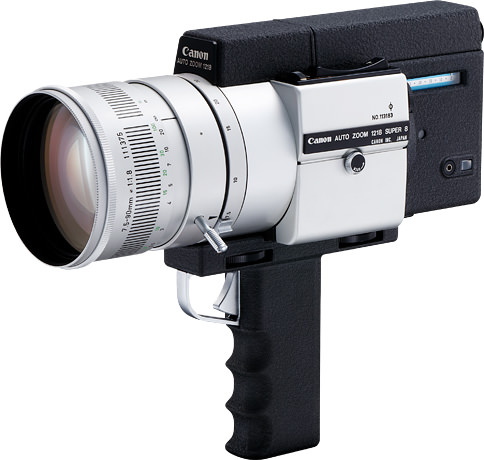 Japan
Japan Americas
Americas Europe, Asia, Oceania
Europe, Asia, Oceania
- Outline
- Specifications
| Marketed | April1968 |
| Original Price | 41,000yen |
More and more families were enjoying TV around this time. This required lenses for TV cameras to have higher zooming ratios for more powerful zooming and close-up effects. Canon also developed high-zoom TV lenses and started development of a 12x zoom lens to introduce the attractiveness of high magnification zooming to the home movie world. Automatic design using a computer reached the level for actual design work around this time, and Canon used it for the first time for development of this lens. This new technology could achieve a compact and comparatively affordable 12x f/1.8 zoom lens with 19 elements in 13 groups for 8mm movie cameras. A “multi-layer coating” was applied for the first time on an 8mm movie lens, and it could supply high-contrast images.
The body was based on the Zoom 518, but two AA batteries and a mercury cell compartment were added at the side of the die-cast exterior. A detachable grip was also available.
| Type | Super 8 type 8mm movie camera | |
| Image Size | 4.2 x 5.7 mm (Projection image size: 4 x 5.4mm) | |
| Film | Super 8 film cartridge | |
| Lens | Focal Length/Speed | 7.5 – 90mm f/1.8 (19 elements in 13 groups, including 6 new type glass elements). Inner diameter: 82 mm, outer diameter: 85 mm. Multi-layer spectra coating. |
| Zooming Ratio | 12x | |
| Focusing | Manual (Front lens group rotating method), 1.8 m to infinity | |
| Zooming | Dual speeds power zooming with high performance micro-motor. H (high-speed): 3 – 6 sec. L (low-speed): 10 – 12 sec. Manual zooming with zooming lever with rotation angle of 150 degrees. Limitation of zooming: Zooming range can be limited with the zooming limitation lever for both power and manual zooming. |
|
| Filter Size | 82 mm filters (Series IX) | |
| Viewfinder | Type | Single-lens reflex type with non-reverse image |
| Rangefinder | Split-image rangefinder | |
| Dioptric Adjustment | -3 to +1 diopter | |
| Viewfinder Information | Aperture value, exposure meter needle, over/under exposure warnings | |
| Exposure Control | Type | EE with the built-in TTL super high sensitive CdS exposure meter Automatic aperture setting coupled to loaded film speed and shooting speed |
| Exposure Meter | Built-in TTL CdS exposure meter | |
| Metering Range | Entire range of ISO 250 f/1.8, 18 fps – ISO 16 f/16, slow motion | |
| Film Speed | Automatic ISO setting by film cartridge Tungsten type film: ISO 25, 40, 64, 100, 160 and 250 Daylight type film: ISO 16, 25, 40, 64, 100 and 160 |
|
| CCA Filter | A Color Conversion filter A is built-in to use tungsten type film under daylight. The CCA filter is automatically cancelled with loading of a daylight type film cartridge. Manual cancellation of the CCA filter is possible. | |
| Manual Aperture Setting | Shooting at any manual aperture setting is possible. Fading out/in is possible using a ND filter and manual aperture setting together. | |
| Power Source | Two 1.3 V H-D mercury cells | |
| Battery Check | Push button checking | |
| Film Drive | Type | Power filming by a high performance micro-motor |
| Filming Speed | 18, 24 fps, slow motion (Approx. 45 fps) and single frame (with a cable release) | |
| Power Source | Five AA batteries. Sufficient power for 15 film cartridges under normal temperature. | |
| Footage Counter | Counts up. Automatic resetting by unloading of a film cartridge. | |
| Battery Check | Push button checking. | |
| Shutter | Shutter Opening | 165 degrees |
| Release Sockets | Sockets for cable release, remote control and single frame | |
| Shutter Lock Dial | Running lock for continuous shooting and release lock to prevent accidental shutter release (dial type). | |
| Remote Control | Possible with remote switch | |
| Grip | Detachable trigger grip (with wrist strap) | |
| Dimensions (W x H x D) | 89 x 104 x 256 mm | |
| Weight | 2000 g (Body only) | |
| Exclusive Trigger Grip | 32 x 115 x 128 mm / 280 g | |


